Mortality
This page contains information on underlying cause of death in Crawley CCG, life expectancy (at Local Authority level), as well as premature (under 75s) mortality, including infant and child mortality statistics (at Local Authority level).
Underlying cause of death
This section shows the cause of death data for NHS Crawley CCG in 2014.
The Primary Care Mortality Database (PCMD) holds records of the underlying cause for each death. This is based on an international classification of diseases (the International Statistical Classification of Diseases and Related Health Problems 10th Revision, ICD-10, World Health Organization, 2016) which identifies the medical condition judged to be the underlying cause of death. Underlying cause of death can be defined as the disease or injury which initiated the train of morbid events leading directly to death or the circumstances of the accident or violence which produced the fatal injury.
The underlying cause may be a long-standing, chronic disease or disorder that predisposed the patient to later fatal complications. The diagram below shows the underlying cause of death for deaths registered in 2014 in the NHS Crawley CCG area. The size of each bubble represents the relative number of deaths.
In 2014, the biggest underlying cause of death was disease of the circulatory system (216 deaths, 30.6% of all deaths in the CCG) which includes deaths caused by chronic ischaemic heart disease (61 deaths, 8.6% of all deaths), myocardial infarction (49 deaths, 6.9% of deaths), and stroke (39 deaths, 5.5% of all deaths). The second biggest underlying cause of death in 2014 for NHS Coastal West Sussex CCG was cancer with 205 deaths registered in the CCG being attributed to this disease group.
Life Expectancy
Period expectation of life at a given age for an area, in a given time period, is an estimate of the average number of years a person of that age would survive if they experienced the particular area’s age specific mortality rates for that period throughout the rest of their life (ONS, 2015). The figure reflects mortality among those living in the area in each time period, rather than the mortality among those born in each area. It is not therefore the number of years a person in the area in each time period could actually expect to live, both because the death rates are likely to change in the future and because many of those within the area may live elsewhere for at least part of their lives.
Period life expectancy at birth is not a guide to the remaining expectation of life at any given age. For example, if female life expectancy at birth was 80 years for a particular area, the life expectancy of women aged 65 years in that area is likely to exceed 15 years. This reflects the fact survival from a particular age depends only on the death rates beyond that age, whereas survival from birth is based on death rates at every age. Life expectancy at birth and life expectancy at age 65 are currently available at the Local Authority district level rather than at Clinical Commissioning Group level from ONS.
Life Expectancy at birth
The latest data, for 2012-2014, shows that life expectancy at birth is lowest for males (80.8 years) compared to females (83.9 years) in Crawley, with a gap of over three years between men and women. The gap follows the pattern for the county (80.6 years for males in West Sussex and 84.2 years for females). The figure below shows the gap in Life Expectancy at birth between men and women.
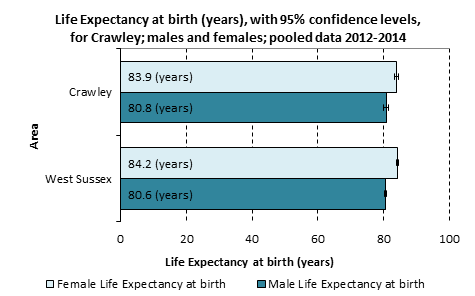
Life Expectancy at birth has increased nationally in recent years as it has in West Sussex and some of its constituent Districts, although due to the smaller number of deaths at these geographies, confidence limits around the estimates are larger and overlap. The figures below show the Life Expectancy at birth for females and for males in Local Authority Districts of NHS Crawley CCG.
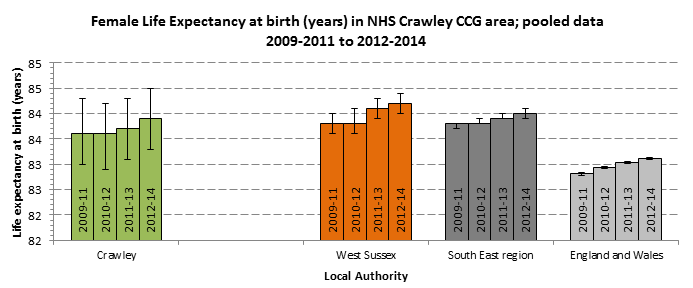
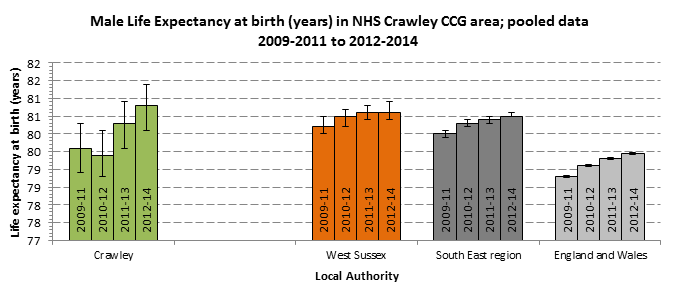
Life Expectancy at age 65
The 2012-2014 data shows that life expectancy at age 65, as it was for life expectancy at birth, is lowest for males (19.4 years) compared to females (21.7 years). The figure below shows the gap in Life Expectancy at age 65 for men and women in Crawley and West Sussex.
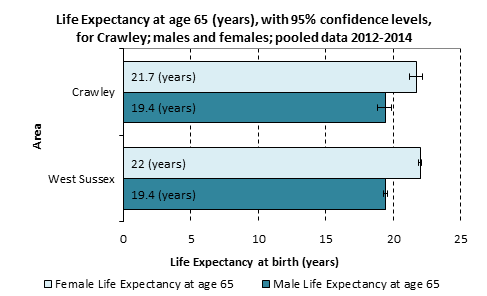
Life Expectancy at age 65 has also increased nationally in recent years as it has in West Sussex and some of its constituent Districts. Again, due to the smaller number of deaths at these geographies, confidence limits around the estimates are larger and overlap, indicating that there may be no statistically significant difference over time. The tables below show the Life Expectancy at age 65 for females and for males in Crawley.
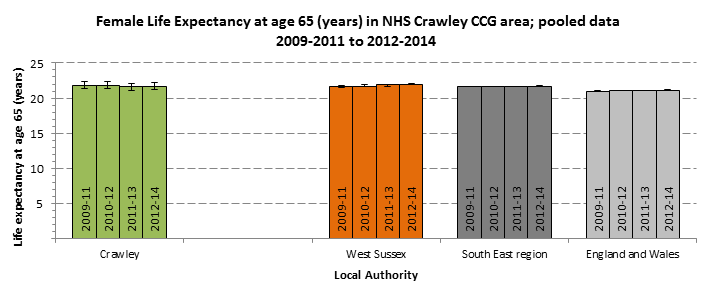
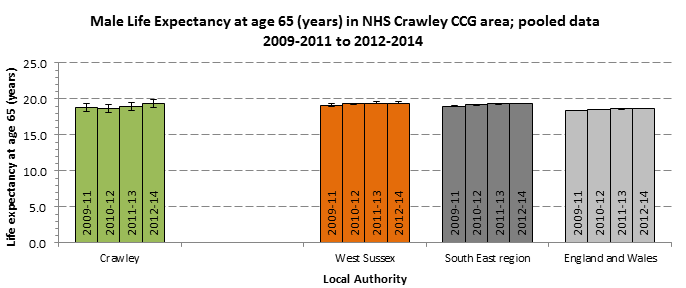
Small Area Life Expectancy at birth
Life Expectancy for small areas is calculated using mortality data aggregated over a number of years to ensure sufficient numbers of deaths are recorded. The most recent data for Life Expectancy at birth at CCG level is for the period 2010-2012. During this period, the Life Expectancy at birth in NHS Crawley CCG for males was 79.4 years (95% CI: 78.8 – 80.1 years) and for females it was 83.6 years (95% CI: 82.9 – 84.2 years). The Life Expectancy at CCG level is not significantly different to England for the period 2010-12 (England males at birth; 79.2 years, 95% CI: 79.2 – 79.2 years, England females at birth; 83 years, 95% CI: 83 – 83 years).
Life Expectancy at an even smaller level (Middle layer Super Output Areas (MSOA)) is available for the period 2009 to 2013. In West Sussex, the male Life Expectancy at birth for 2009 to 2013 (small area based) was 80.4 years and for females it was 84.0 years.
In NHS Crawley CCG, there is nearly a decade difference (9.8 years) in the Life Expectancy at birth for males between the highest and lowest Life Expectancy at MSOA level.
The map below shows the variation in Life Expectancy at birth for males in MSOAs of NHS Crawley CCG for 2009 to 2013. The lowest Life Expectancy at birth for males was 76.2 years (95% CI: 74.6 – 77.8 years) in MSOA Crawley 007 (E02006581), which is located near Southgate. The highest Life Expectancy at birth for males was 86 years (95% CI: 83.5 – 88.6 years) in MSOA Crawley 008 (E02006582) which is near Maidenbower.
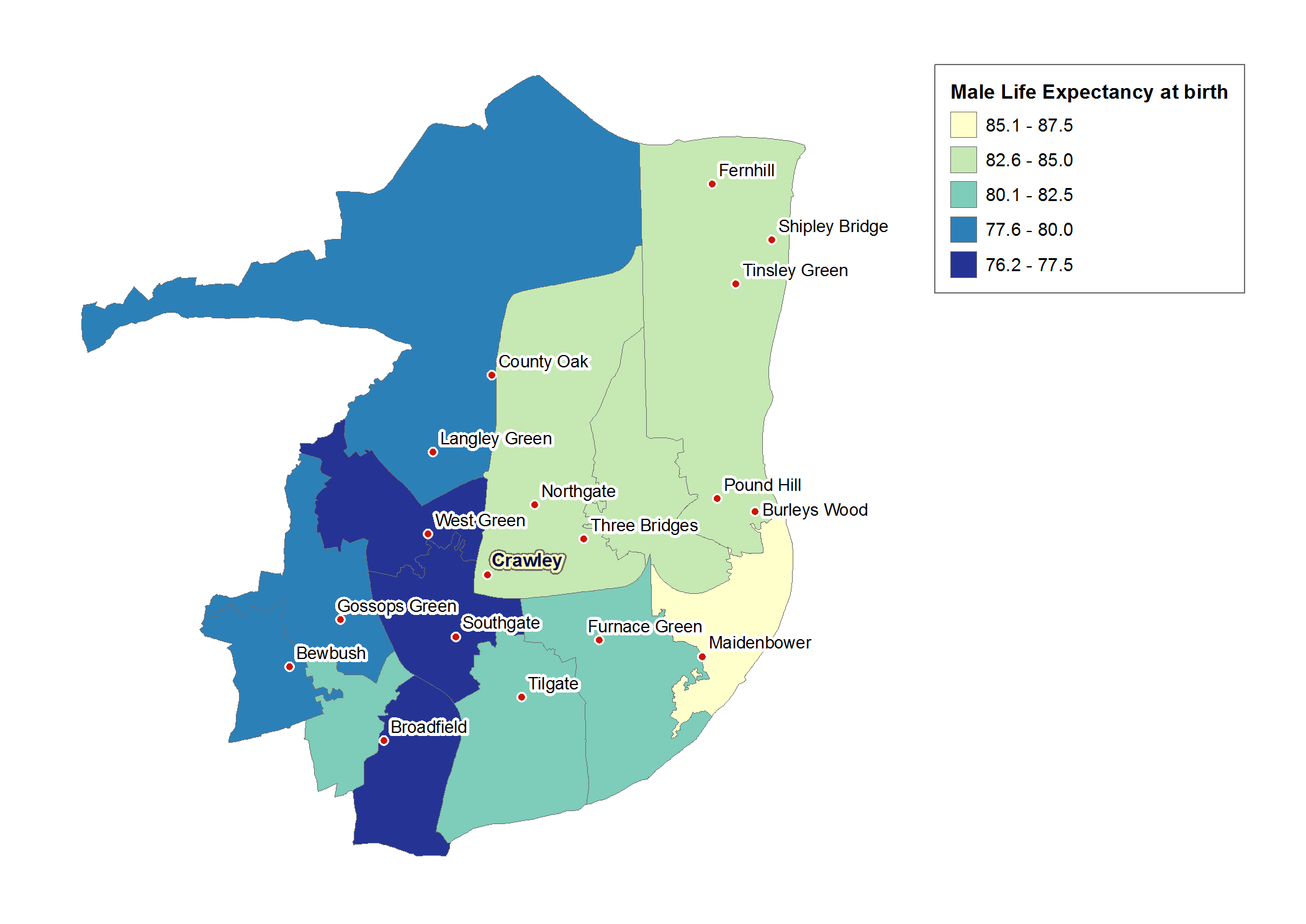
For females in NHS Crawley CCG, there is a gap of 7.5 years between the MSOA with the lowest and highest Life Expectancy at birth for females.
The map below shows the variation in Life Expectancy at birth for females in MSOAs of NHS Crawley CCG for 2009 to 2013. The lowest Life Expectancy at birth for females was 80 years (95% CI: 78.5 – 81.6 years) which is again in MSOA Crawley 007 (E02006581) located on near Southgate. The highest Life Expectancy at birth for females was 87.5 years (95% CI: 85.5 – 89.6 years), in MSOA Crawley 011 (E02006585), south of Tilgate.
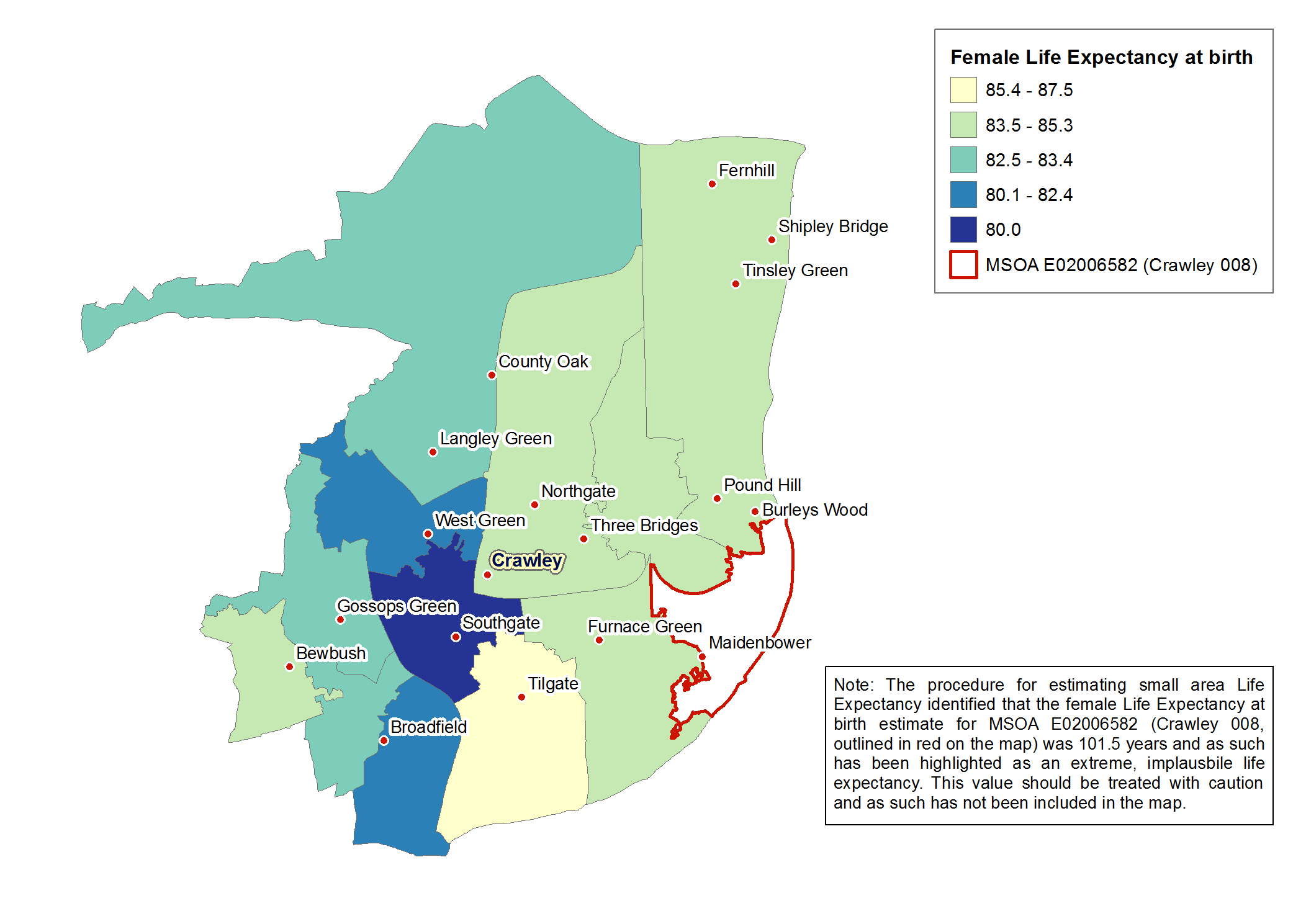
Premature mortality
In England, in 2012-14, one in three people died before the age of 75. Deaths before this age are considered to be premature. Longer Lives is a web tool from Public Health England (available here) to higher premature mortality across Local Authority districts and counties in England. Data are drawn from records of deaths reported each year by the Office for National Statistics and are available in the Public Health Outcomes Framework (PHOF).
Premature mortality data in the Longer Lives tool are given as directly standardised rates per 100,000 (using the European Standard Population, ESP 2013) to enable comparisons across areas which have dissimilar population age structures. Standardising takes into account that death rates are higher in older populations. Data are pooled across three year periods to ensure that there are a sufficient number of deaths in each area to enable robust calculation of rates
The chart below shows the directly age-standardised rate of premature mortality (under 75s deaths per 100,000 ESP 2013) in Crawley for years 2011-13 and 2012-14.
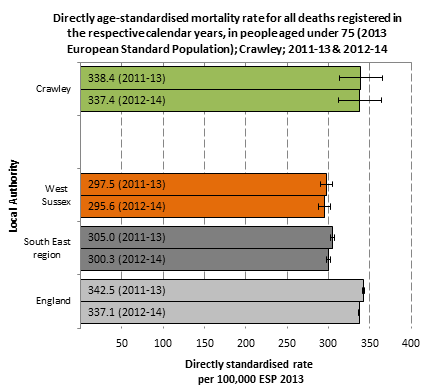
In Crawley, 726 deaths were recorded among those aged under 75 years in 2012-14. The standardised rate of 337.4 deaths per 100,000 ESP 2013 (95% CI: 312.5 – 363.7 deaths) in 2012-14 for Crawley meant that it was 195th out of 324 Local Authority Districts nationally when ranked in order of lowest to highest premature mortality rate. The premature mortality rate in Crawley was significantly higher than the rate for West Sussex (295.6 deaths per 100,000 ESP 2013, 95% CI: 288.5 – 302.8 deaths) and South East region (300.3 deaths per 100,000 ESP 2013, 95% CI: 298 – 302.6 deaths) for 2012-14 but was statistically similar to the England rate for the same period (337.1 deaths per 100,000 ESP, 95% CI: 336.1 – 338.1).
Infant mortality
Infant mortality rate is expressed as the number of deaths of infants aged under 1 year per 1,000 live births. Nationally, the latest infant mortality data available (using pooled data from January 2012 to December 2014) shows that there were 4 deaths per 1,000 live births to infants in the first year of life. In West Sussex, during the same period, there were 3.4 deaths per 1,000 live births and this is statistically similar to the England rate.
In 2012-14 there were 13 deaths among infants under the age of 1 who were resident in Crawley. The trend in infant mortality rate for Crawley between 2008-10 and 2012-14 is given in the chart below. The number of deaths at district level are generally very small and as such, estimates are accompanied by large confidence intervals indicating that there may be little or no change over time. In 2012-14, the directly-age standardised rate or infant mortality was 2.6 deaths per 1,000 live births (95% CI: 1.4 – 4.5 deaths), which is not significantly different to West Sussex, the South East region, or England.
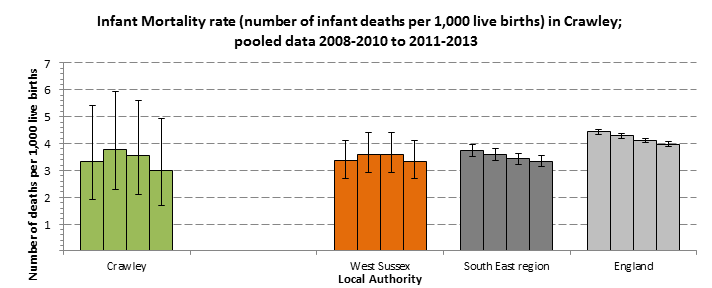
Child Mortality
After the age of one year, injury is the most common cause of death in young people; and many of these injuries are potentially avoidable. At CCG level child mortality statistics include the number of deaths to those aged 1 year to 17 years per 100,000 European Standard Population (2013 ESP). Data is currently only available for the period 2012-14 and this indicates that there were less than five deaths among children aged 1 year to 17 years in NHS Crawley CCG at a rate of 5.3 deaths per 100,000 ESP 2013 (95% CI: 1.4 – 13.6 deaths). This was not significantly different to the rate for NHS Coastal West Sussex CCG (8.9 deaths per 100,000 ESP 2013, 95% CI: 5.7 – 13.4), NHS Horsham and Mid Sussex CCG (8.2 deaths per 100,000 ESP 2013, 95% CI: 4.2 – 14.3 deaths) or England (12 deaths per 100,000 ESP 2013, 95% CI: 11.6 – 12.3 deaths). The small number of deaths, as reflected in the large confidence intervals, indicate that the estimates of mortality are highly variable.